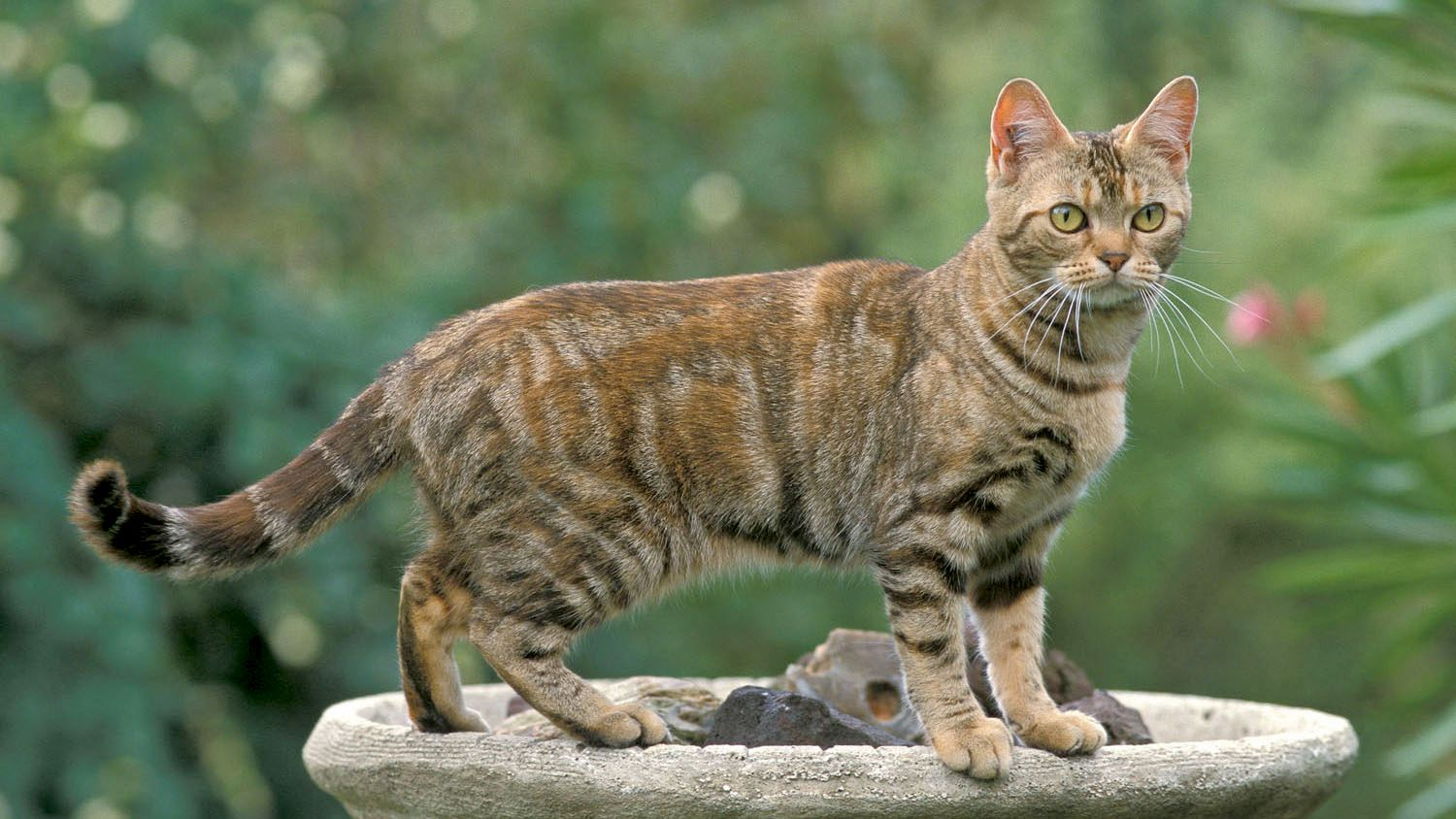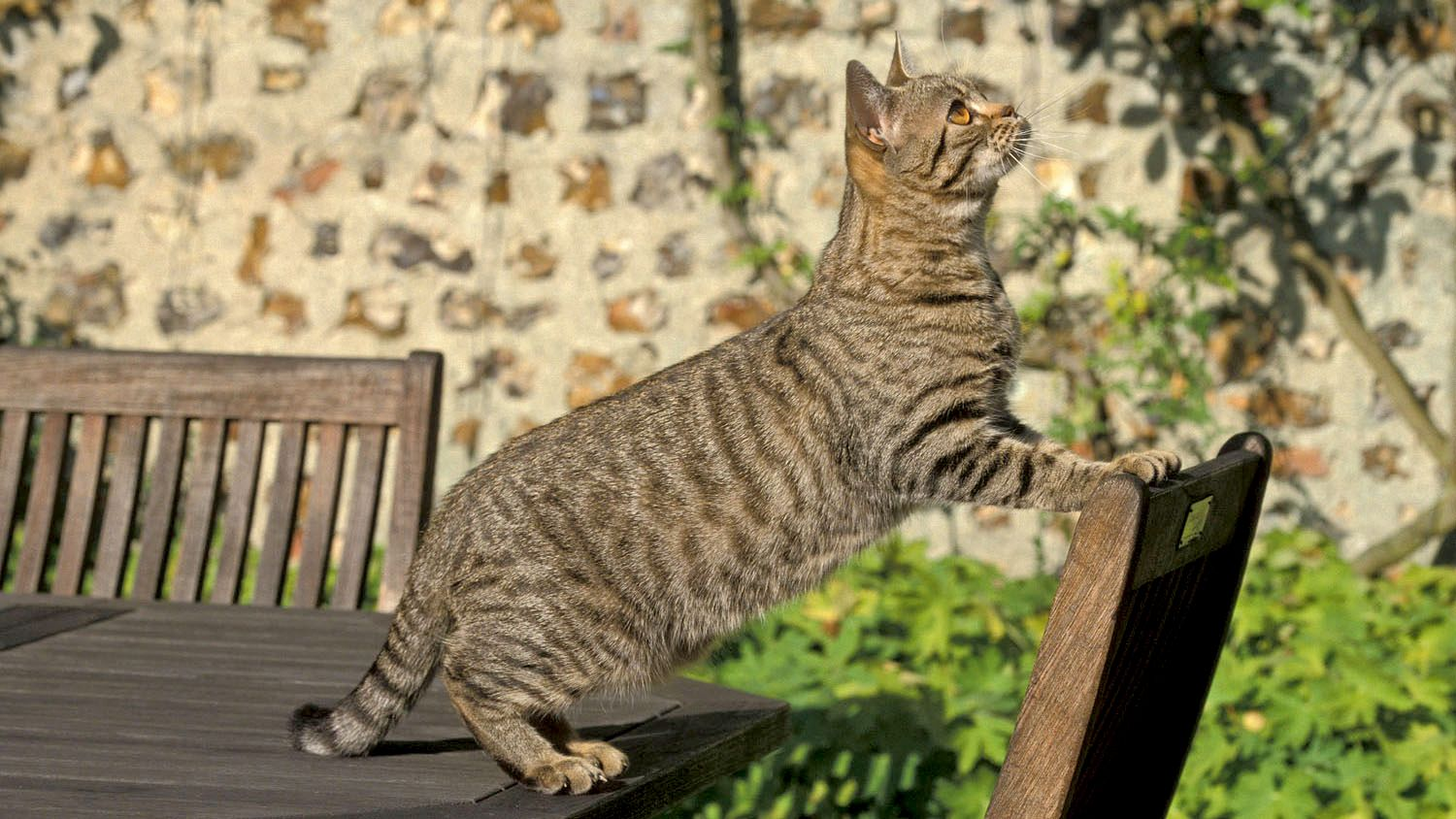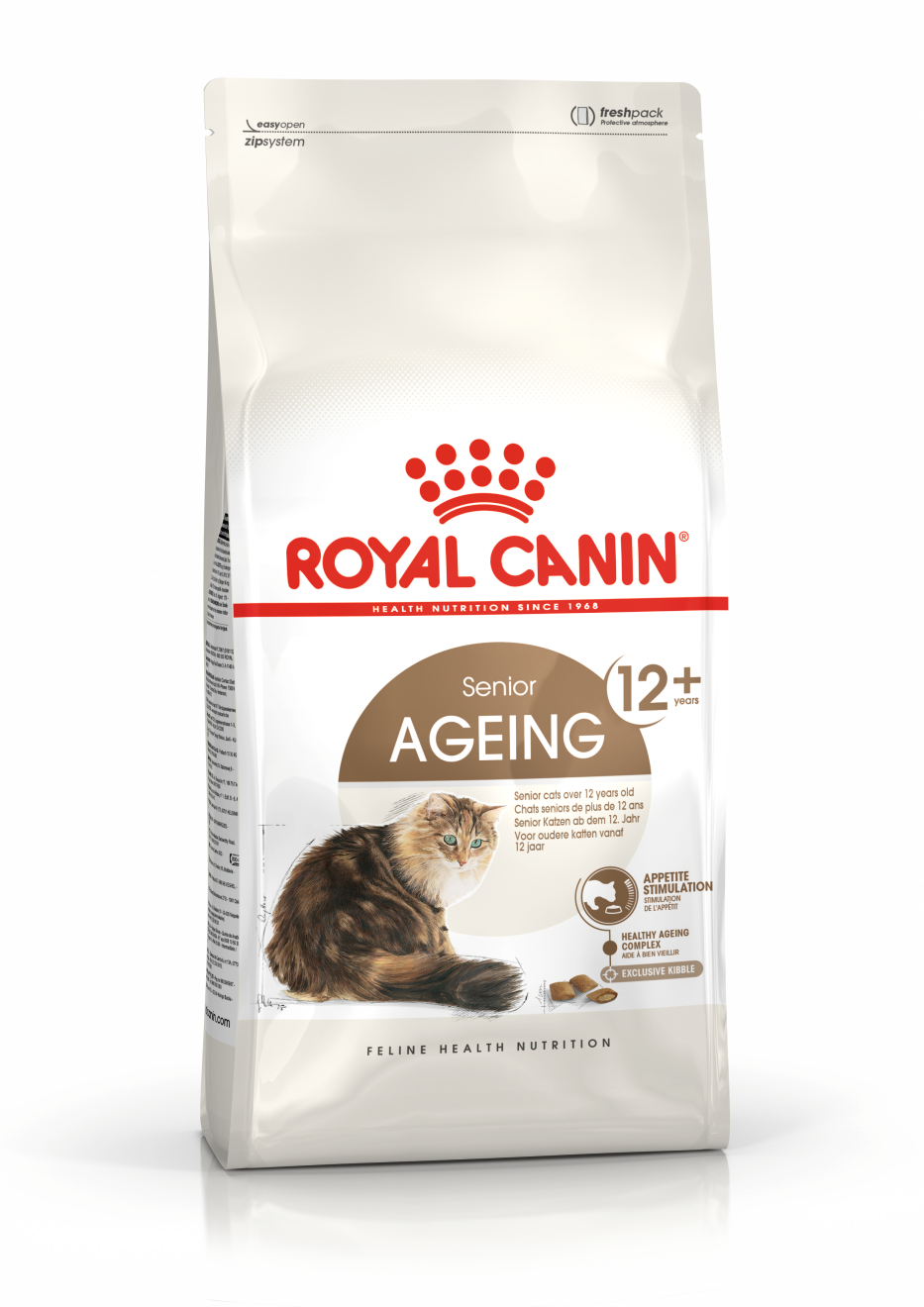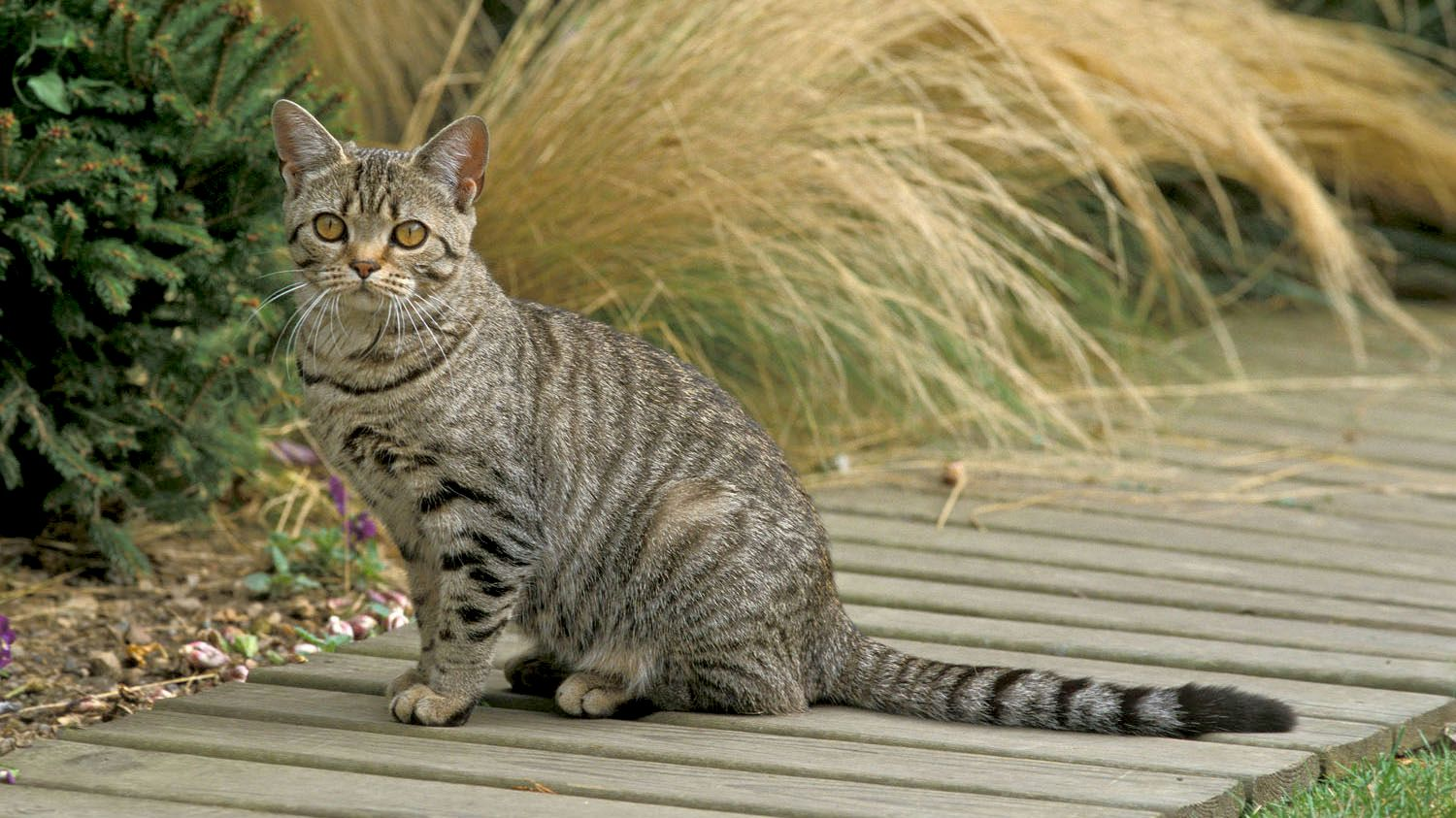American Shorthair - Breed Facts & Characteristics
Regarded as the American forebearers of the US cat family, this popular breed was originally brought over from Europe in the 1600s. Used by seafarers to control the rodent population on board the ships, the American Shorthair still retains something of that hunting instinct today (keep a close eye on your computer mouse). Strong, agile and lively, they are also notable for their beautiful and highly varied coloring. Most of all, though, the American Shorthair makes an affectionate, gentle pet who will often form a strong attachment to their owners.
Official name: American Shorthair
Origins: USA
Hair length
1 out of 5Shedding Level
3 out of 5Grooming needs
2 out of 5Energy level*
3 out of 5Vocal
1 out of 5Family pet?*
4 out of 5Compatibility
4 out of 5Can stay alone
3 out of 5Environment (indoor/outdoor)
3 out of 5
| Male | Female |
|---|---|
| Height | Height |
| 20.5 - 25.5 cm | 20.5 - 25.5 cm |
| Weight | Weight |
| 5 - 7 kg | 3.5 - 5 kg |
| Life stages | |
|---|---|
| Kitten | Adult |
| 4 to 12 months | 1 to 7 years |
| Mature | Senior |
| 7 to 12 years | From 12 years |
Hair length
1 out of 5Shedding Level
3 out of 5Grooming needs
2 out of 5Energy level*
3 out of 5Vocal
1 out of 5Family pet?*
4 out of 5Compatibility
4 out of 5Can stay alone
3 out of 5Environment (indoor/outdoor)
3 out of 5
| Male | Female |
|---|---|
| Height | Height |
| 20.5 - 25.5 cm | 20.5 - 25.5 cm |
| Weight | Weight |
| 5 - 7 kg | 3.5 - 5 kg |
| Life stages | |
|---|---|
| Kitten | Adult |
| 4 to 12 months | 1 to 7 years |
| Mature | Senior |
| 7 to 12 years | From 12 years |

Find the right product for your cat
Answer a few questions about your cat
Get their tailored food recommendation
Support your cat's health with the right diet

Get to know the American Shorthair
All you need to know about the breed
Renowned for their easy-going, relaxed personality, American Shorthairs are also quite a playful breed of cat. As such, they tend to be popular with families, especially as they are known to be good with children. Generally speaking, they also get along well with other cats and dogs.
Originally brought to the US by early settlers in the 1600s, these seafaring cats were used to protect the ship’s supplies from mice and other rodents. On their arrival in the US, they soon became a fixture in domestic homes – and were eventually adopted by the Americans as their own.
Medium in size, American Shorthairs are known for their beautiful and varied colors and markings. In fact, there are more than 60 variations in the breed. One of the most striking, though, must surely be the sterling silver coat, which can also be flecked with black markings.
As a short-haired breed of cat, the American Shorthair doesn’t require much maintenance from their owners – and are also known for their generally healthy countenance. In fact, the American Shorthair has a longer-than-average lifespan that can easily reach between 15 and 20 years.
This resilience comes in part from their origins as a self-sufficient hunting cat. In short, there’s not much that fazes this plucky feline.
While it’s true that the American Shorthair likes to play, they are equally happy when curled up on the sofa. They are also just the right mix of independence and affection. Though they like to do their own thing to some extent, they also appreciate the attention and caresses of their owner with whom they can often form a strong bond.

Two facts about American Shorthairs
1. Presidential pretensions
Did you know that the American Shorthair has even made it into the White House? Former president George Bush and his family owned an American Shorthair named India.
2. Happy 400th birthday
It is thought that some of the American Shorthair’s ancestors may have travelled on board the ‘Mayflower’ herself. If that was the case then 2020 would have marked the 400th anniversary of the breed. So, many happy returns to this classic American cat!
History of the breed
Although they have long been claimed by the US as their own, the American Shorthair breed has its original roots in Europe. During the 1600s, however, they were brought over by the adventurers who tried their luck on the high seas.
Back then, these early American cats were used to protect the ship’s precious cargo from mice and rats. Strong and sure-footed animals, they had a keen intelligence about them too. They were also notable for the variety of colors and patterns in their coats.
On their arrival in the US, they were initially utilized by farmers and shopkeepers for their hunting skills. Before long, though, people also began to recognize their value as domestic animals. It was then that they became popular as family pets.
Later, in the 1800s, there developed a sudden surge in showing cats. So, it was decided that there should be a representative of the breed. In 1906, official recognition as the ‘Domestic Shorthair’ was given.
Finally, in the early 1960s, the breed was renamed the ‘American Shorthair’ that we know today. The icing on the cake came in 1965 when an American Shorthair was declared ‘Best Cat of the Year’ by the Cat Fanciers Association (CFA) – a title devotees would argue stands true every year.
From head to tail
Physical characteristics of American Shorthairs
1.Head
2.Body
3.Tail
4.Fur
5.Coat

Things to look out for
From specific breed traits to a general health overview, here are some interesting facts about your American Shorthair
They can potentially suffer from heart disease.
Although a generally healthy breed of cat, with an average lifespan of 15 to 20 years, the American Shorthair can be prone to a few possible health problems. One of the most common of these is a condition called hypertrophic cardiomyopathy – which is a thickening of the heart muscle. Symptoms can include rapid breathing, general fatigue and a disinterest in their food. While the disease unfortunately has no cure as yet, the good news is that it can be managed. Your vet will be able to advise on a combination of medication and a bespoke diet for your American Shorthair.
It’s important to keep their weight in check.
Another thing to be aware of with the American Shorthair is their propensity to put on weight. As this is a trait that the breed is particularly prone to, they can easily become obese without proper exercise and an appropriate diet – and this is especially true for neutered cats. If your American Shorthair seems to be gaining weight, they may need a tailored nutrition programme. Have a chat with your vet who will be able to advise on this – and be sure to avoid any unhealthy treats.
They can also be prone to joint problems
In particular, the American Shorthair can be susceptible to a condition called hip dysplasia, a hereditary disorder where the ball and socket become misaligned. There can be various visible signs of this – for example, if your cat starts moving slowly, limping or avoids jumping. While the condition can’t be cured, it can be managed. Depending on the severity, weight management, medication and surgery can all help to alleviate the symptoms. Choosing a responsible breeder can also reduce the risk, as they will be screening for the condition in the kittens’ parents, and it’s important to keep your cat’s weight in check too.
Healthy diet, healthier cat

Tailored health nutrition has a fundamental role to play in maintaining the health and beauty of American Shorthair cats. Food provides energy to help with vital functions and a complete nutritional formula for cats should contain an adapted balance of nutrients. Feeding them in this way will offer a diet that’s neither deficient nor excessive, both of which could have adverse effects on your cat’s health. Clean, fresh water should be available at all times to support good urinary regularity. Cats are also naturally adapted to eating small servings – between 7 and 10 times a day. Giving them the recommended daily ration of kibble once a day will let the cat regulate their own consumption; ironically, when they have only one or two servings a day, their weight increases more than a cat who eats on demand. The following recommendations are for healthy animals. If your cat has health problems, please consult your veterinarian who will prescribe an exclusively veterinary diet.
Growth is an essential stage in the kitten’s life: it is a time of big changes, discoveries and new encounters. An American Shorthair kitten’s requirements, in terms of energy, protein, minerals and vitamins, are much greater than those of an adult cat. They need energy and nutrients to maintain their body, as well as to grow and build new cells. A kitten’s growth can be divided into two phases:
Construction
From birth to 4 months
Weaning is the transition a kitten makes from liquid – or maternal milk – to solid food. This period naturally corresponds to the time when they cut their milk teeth, at 3 to 6 weeks old. At this stage, kittens are not yet able to crunch, so a soft meal (rehydrated kibble or an adapted wet food) helps facilitate the transition between liquids and solids.
Between 4 and 12 weeks after birth
the natural immunity a kitten receives from the mother’s colostrum - or first milk - decreases while the kitten’s immune system gradually develops. This critical time, called the immunity gap, requires a complex of antioxidants, including vitamin E, to help support their natural defences. Kittens go through an intense and particularly delicate period of growth during which they’re prone to digestive upset. Their diet at this time should not only be rich in energy to meet their increasing growth needs but should also contain highly digestible protein to cater to their digestive system that’s still maturing. Prebiotics, such as fructo-oligosaccharides, can also support their digestive health by helping to balance intestinal flora. The result? Good stool quality, all the time. The kitten’s food should contain omega 3 fatty acids - EPA-DHA - which helps support the proper neuro-cerebral development.
Consolidation and Harmonisation: from 4 months to 12 months
From the fourth month, a kitten’s growth slows down, so a food lower in fats is recommended. This is particularly important after a cat is neutered. Between 4 and 7 months, a kitten’s milk teeth fall out and are replaced by permanent ones. When the adult teeth have come through, a kitten needs to eat kibble that’s big enough so they’re encouraged to crunch. Until they’re 12 months old, an American Shorthair kittens’ immune system is still gradually developing. A complex of antioxidants, including vitamin E, can help support their natural defences during this time of big changes, discoveries and new encounters. The digestive system matures progressively, with digestive ability reaching full maturity toward twelve months of age. A cat is then able to consume adult food.

On top of maintaining a healthy urinary function as for all cats, the main nutritional goals for adult American Shorthairs are:
Contributing to maintaining an ideal body weight for this strongly built and powerful cat, by combining a moderate fat level with balanced fibres with adjusted content of high-quality proteins enriched with L-carnitine, which is important for healthy fat metabolism.
Helping to preserve the health and beauty of their skin and their short lustrous coat, with the enriched addition of targeted nutrients such as specific amino acids, vitamins and omega-3 and omega-6 fatty acids.
Supporting optimal digestion and balancing intestinal flora by using highly digestible proteins and prebiotics
Supporting good oral hygiene thanks to a kibble shape adapted to their medium-short muzzle, and a texture that encourages them to chew

A senior cat – one over the age of 12 – may sometimes have difficulties with digestion. To maintain the weight of the ageing cat and minimise the risk of deficiencies, they should be given an extremely digestible food filled with essential nutrients.
As they get older, cats increasingly suffer from teeth problems, and in some senior cats, the sense of taste and smell may decline as well, which leads to a lowered intake of food. To ensure they continue to eat enough, the shape, size and hardness – meaning texture – of their kibble needs to be tailored to their now potentially more fragile jaw.
Note that the best energy level for any cat still depends on their lifestyle, even those who are ageing. A senior cat that continues to go out regularly will benefit from a diet with a slightly higher fat content. On the other hand, ageing does not reduce an indoor cat’s risk of obesity. Their calorie intake should still be closely monitored. A food with a moderate fat content then may be optimal.

Caring for your American Shorthair
Grooming, training and exercise tips
With their laid-back temperament, the American Shorthair tends to have a fairly relaxed approach to life. However, this does mean they can be prone to gaining weight, if they don’t have enough exercise, which can have serious consequences for their health. One good way to keep your American Shorthair in shape is with daily play sessions together. This will help to ensure they burn off some calories. A cat tree can also provide a good source of activity and mental interest for them. You'll probably find if you have another cat, they'll get some exercise with their kitty companion.
A very easy breed to look after in terms of grooming, the clue is in the name with the American Shorthair. Their short, smooth coats require just a weekly combing or brushing. Also, while the American Shorthair does tend to shed a little bit, it’s only an average amount. In addition, they should have their teeth brushed daily to prevent any dental problems and nails trimmed as needed – though they should have a scratching post, too, as this is important for their well-being. Ears should also be checked regularly for any debris, wax or irregularities. If you have questions or concerns, consult your veterinarian. Lastly, it is recommended that your American Shorthair has a professional grooming session from time to time.
With their strong hunting instinct, the American Shorthair will take pleasure in chasing anything that moves. As such, it’s best to keep them apart from other smaller pets to avoid any incidents. However, they normally get along well with other cats and dogs and usually settle in well to life in the domestic home. Because of their natural intelligence and innate hunting skills, American Shorthairs will enjoy having some toys to play with (if these have a ‘hunting’ element to them so much the better or your curtains may become easy prey). A scratching post will also help to divert them away from the legs of your best table.
With their laid-back temperament, the American Shorthair tends to have a fairly relaxed approach to life. However, this does mean they can be prone to gaining weight, if they don’t have enough exercise, which can have serious consequences for their health. One good way to keep your American Shorthair in shape is with daily play sessions together. This will help to ensure they burn off some calories. A cat tree can also provide a good source of activity and mental interest for them. You'll probably find if you have another cat, they'll get some exercise with their kitty companion.
A very easy breed to look after in terms of grooming, the clue is in the name with the American Shorthair. Their short, smooth coats require just a weekly combing or brushing. Also, while the American Shorthair does tend to shed a little bit, it’s only an average amount. In addition, they should have their teeth brushed daily to prevent any dental problems and nails trimmed as needed – though they should have a scratching post, too, as this is important for their well-being. Ears should also be checked regularly for any debris, wax or irregularities. If you have questions or concerns, consult your veterinarian. Lastly, it is recommended that your American Shorthair has a professional grooming session from time to time.
With their strong hunting instinct, the American Shorthair will take pleasure in chasing anything that moves. As such, it’s best to keep them apart from other smaller pets to avoid any incidents. However, they normally get along well with other cats and dogs and usually settle in well to life in the domestic home. Because of their natural intelligence and innate hunting skills, American Shorthairs will enjoy having some toys to play with (if these have a ‘hunting’ element to them so much the better or your curtains may become easy prey). A scratching post will also help to divert them away from the legs of your best table.
7/7
All about American Shorthairs
Other breeds that might interest you
Read more on this topic
Sources
- Veterinary Centers of America https://vcahospitals.com/
- Royal Canin Cat Encyclopaedia. Ed 2010 and 2020
- Banfield Pet Hospital https://www.banfield.com/
- Royal Canin BHN Product Book
Like & share this page